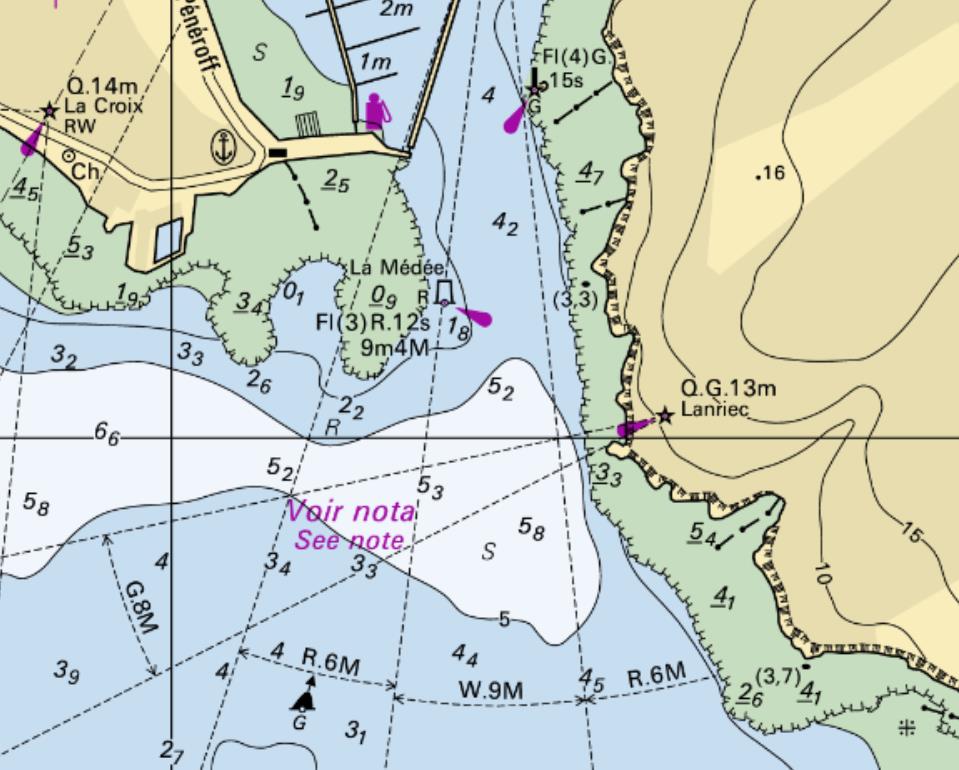Nautical information
Mis à jour le 19/07/2024
Naviguer en sécurité
Pour les marins civils ou militaires, de commerce, de pêche ou de plaisance, naviguer en sécurité suppose de disposer des meilleures informations pour comprendre l’espace maritime d’un point de vue nautique, pour s’y repérer et choisir sa route, en considérant bien sûr aussi les conditions météorologiques et le trafic.
Les informations nécessaires
La bathymétrie et les obstacles sous-marins, la topographie des côtes et leur balisage, les zones de navigation réglementée, les installations en mer, les ports et leurs approches, les radio-services, la marée, les courants, les dangers nouveaux (un phare éteint, un conteneur à la dérive, un exercice de tirs, un haut-fond nouvellement découvert, etc…) sont autant de sujets à décrire à l’adresse du navigateur pour l’aider dans ses analyses et ses décisions, pour la préparation et le suivi de sa route. La carte marine, imprimée ou numérique (sous la forme de base de données ou d’image), est le support emblématique de ces renseignements mais elle ne peut seule véhiculer toute l’information dans les délais appropriés.
L’information nautique, de l’avertissement de navigation à la carte marine
L’espace maritime évolue et les renseignements pertinents et la manière dont ils sont délivrés aux navigateurs constituent l’information nautique. Celle-ci revêt plusieurs formes complémentaires selon la nature des renseignements et le degré d’importance et d’urgence qui s’y attache.
Ainsi, l’information nautique est portée par :
- les avertissements urgents de navigation radiodiffusés,
- les avis aux navigateurs locaux,
- les produits et services nautiques du Shom, dont les cartes marines et les publications nautiques qui les complètent, et leurs mises à jour.
Ces services d’information nautique sont organisés au niveau mondial sous l’égide de l’Organisation maritime internationale (OMI) dans le cadre de la convention SOLAS (Safety Of Life At Sea) ratifiée par la France.
Une organisation participative
Cela suppose évidemment une organisation au niveau national pour remonter, recueillir, élaborer et diffuser l’information nautique dans ses différentes formes. Cette organisation, objet d’une instruction du Premier ministre (NOR : PRMM2002228A) et dont le Shom est le coordonnateur national, implique de nombreux services et administrations maritimes ainsi que des opérateurs publics et privés et les usagers, qui sont les meilleurs observateurs en mer.
La participation de chacun à ce flux d’informations bénéficie à la communauté maritime et contribue à une navigation efficiente et sûre dans les eaux françaises.
PING, la plateforme nationale de l'information nautique
Centralisant les informations nautiques au niveau national, PING est un site qui permet à l'ensemble de la communauté maritime de remonter ces informations. Une fois traitées par les autorités maritimes, elles sont mises en ligne à destination de tous. Modernisant le dispositif existant, PING matérialise l'organisation nationale de l'information nautique et en favorise une large diffusion par la numérisation. Cette plateforme est co-éditée par le Shom et la direction générale des affaires maritimes, de la pêche et de l'aquaculture (DGAMPA).
Les produits et services du Shom
Nourri par les données et informations collectées, le Shom intègre à ses produits nautiques (les cartes et leurs compléments) les éléments nouveaux lorsque leur durée de validité est compatible avec le délai de mise à jour des produits. Les processus rigoureux de réalisation mobilisent les experts de plusieurs domaines pour rassembler les données, les qualifier, les compiler et élaborer les informations adaptées à la navigation dans le respect des normes applicables, telles que les normes de cartographie marine.
La navigation étant par nature internationale, il est important d’harmoniser les produits et les services. Le Shom participe activement aux travaux normatifs, notamment au sein de l’Organisation hydrographique internationale (OHI) ; un objectif pour le Shom et ses homologues des autres pays étant d’adapter plus encore les produits et services aux problématiques de navigation compte tenu de l’avancée des technologies et de l’évolution du trafic.
Les grandes commissions nautiques (GCN)
Les commissions nautiques permettent de consulter les navigateurs sur les projets de réalisation et de transformations d'équipements civils intéressant la navigation maritime. Elles ont été instituées par le décret n° 86-606 relatif aux commissions nautiques.
Il existe des commissions nautiques locales et des grandes commissions nautiques, selon le type de dossier instruit.
Les grandes commissions nautiques comprennent deux membres permanents :
- un officier supérieur de la Marine nationale président ;
- un ingénieur de l'armement appartenant au Shom.
Une nouvelle commission est créée pour l'instruction de chaque dossier. Le secrétariat de la grande commission nautique est assuré par le Shom.

